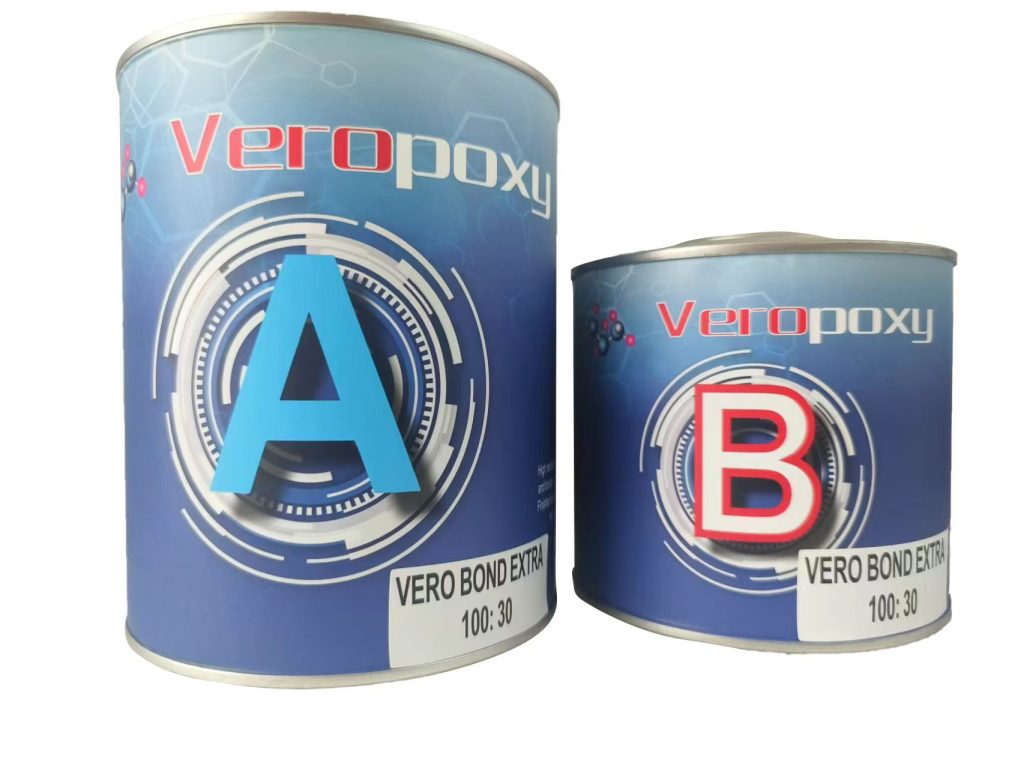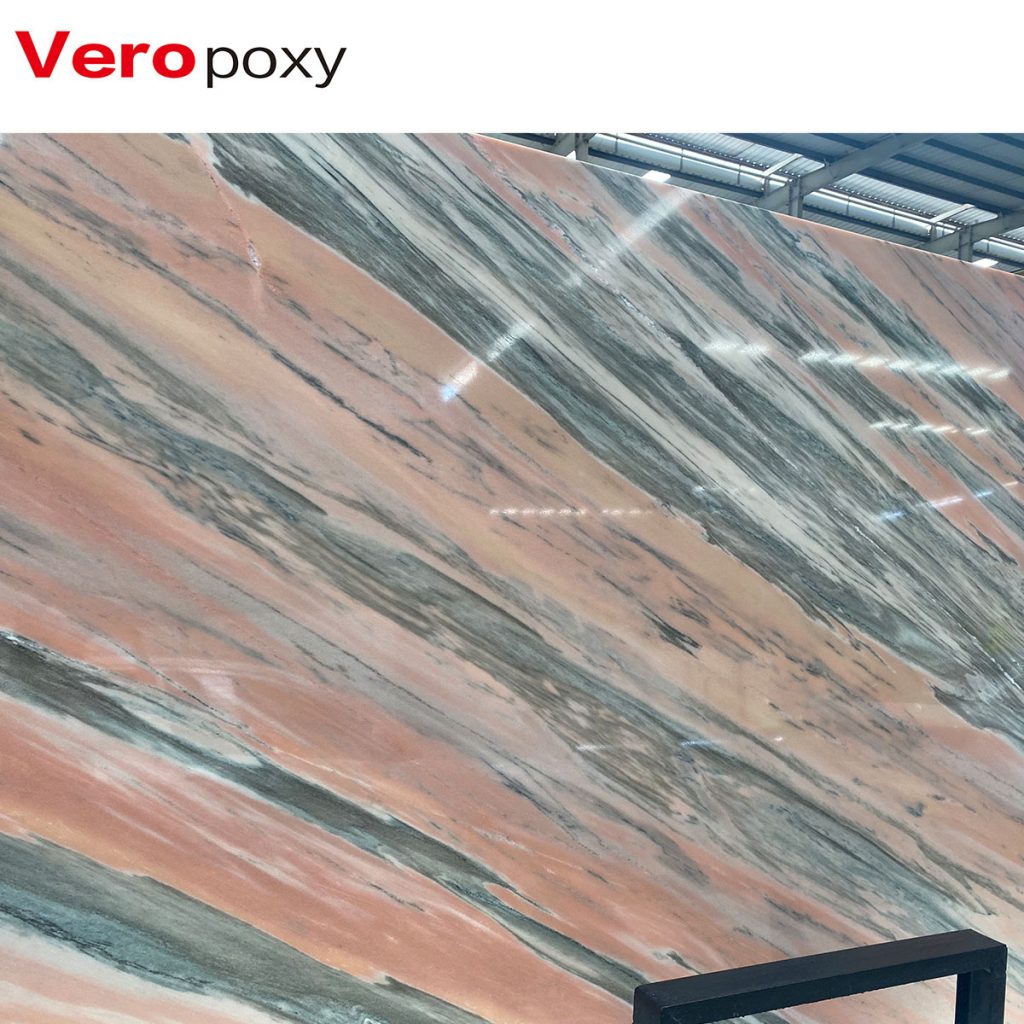In the field of architectural decoration, marble is highly favored for its unique texture and beautiful appearance. However, marble floors will inevitably have problems such as scratches and damage during use, affecting its overall beauty and service life. Fortunately, with the development of material technology, epoxy resin provides an efficient and reliable solution for the repair of marble floors. This article will introduce in detail the application of epoxy resin in marble floor repair, including its characteristics, repair methods and advantages.

Vero Bond epoxy resin
Characteristics of epoxy resin
Epoxy resin is an organic polymer compound containing two or more epoxy groups in the molecule, usually used in the form of liquid resin. It has high bonding strength, can be tightly bonded to the marble surface, is not easy to crack, and ensures that the repaired part is firmly connected to the original stone. At the same time, the shrinkage rate of epoxy resin during the curing process is relatively low, which means that during the repair process, after the epoxy resin is filled into the scratched or damaged part, there will be no obvious depression after curing, thereby ensuring the flatness of the repaired surface.
In addition, the molecular weight of epoxy resin is appropriate, and its viscosity can be adjusted as needed. It can not only infiltrate and penetrate into the tiny cracks of marble well, realize comprehensive repair from the inside to the surface, but also cure at room temperature, and accelerate curing by heating, which provides great flexibility for the construction process.
Methods of repairing marble floors with epoxy resin
Preparation before repair
Before using epoxy resin to repair marble floors, you need to make adequate preparations. First, clean up the debris and dust around the damaged floor, and ensure that the repair area is dry and oil-free. This step is essential to ensure good bonding between epoxy resin and marble surface.
Secondly, carefully check the condition of the damaged floor, including the damage range, depth, whether there are cracks, etc., which will help determine the repair plan and the type and amount of materials required. Finally, according to the damage, prepare the corresponding epoxy resin repair materials, curing agents, fillers, color pastes, etc., and ensure that the selected materials are compatible with the original floor materials to ensure the repair effect.
Repair scratches
For scratches on marble floors, the following steps can be used for repair. First, use acetone and a nylon brush to remove excess marble particles from the scratched area, which helps improve the adhesion of the epoxy resin to the marble surface. Then, mix the epoxy resin and curing agent in an appropriate ratio, usually 1/10. If needed, pigments and fillers can also be added to the epoxy resin to match the color of the repaired marble with the original marble.
Next, apply the prepared epoxy resin evenly to the scratch, ensuring that the epoxy resin fully fills the scratch. You can use a scraper or brush to operate it, and be careful not to leave bubbles. Finally, let the epoxy resin cure naturally. Depending on the ambient temperature and the type of epoxy resin, the curing time may vary from a few hours to a day. After curing, use a grinder or sandpaper to polish the repaired area to make it level with the surrounding ground.
Repair damage
For marble floor damage, the repair steps are as follows. First, if the damaged area is large, you need to cut off the damaged part first to form a regular repair boundary, which helps ensure that the epoxy resin can be evenly filled into the damaged area and tightly bonded to the surrounding ground after curing.
Then, according to the damage, mix an appropriate amount of epoxy resin mortar. Epoxy resin mortar is usually composed of epoxy resin, curing agent, filler and quartz sand. This mortar has high strength and good filling properties, and can effectively repair the damaged parts of the marble floor. Then, fill the prepared epoxy resin mortar into the damaged area, use a scraper to scrape it flat, and ensure that the material is flush with the original floor. During the filling process, be careful to avoid air from entering to prevent the formation of bubbles.
Finally, after waiting for the epoxy resin mortar to solidify, use a grinder to grind the entire repair area so that the repaired part is flat with the original floor. When grinding, pay attention to controlling the strength and speed to avoid damage to the original floor.
Repair hollowing
Marble floor hollowing is one of the common problems. The epoxy resin steel bolt anchoring method can effectively solve this problem. The specific steps are as follows. First, for the hollow stone that needs to be repaired, determine the drilling position and number, and use an electric drill equipped with a carbide insert drill bit to drill a 5mm fine hole. When drilling, the drill bit should be tilted downward at a 15-degree angle to prevent the epoxy resin slurry from flowing out of the hole after grouting.
Then, after the hole is drilled, use an air compressor to remove the dust in the hole. The dust removal air machine should be inserted to the bottom of the hole so that all the dust escapes from the hole with the compressed air.
Then, use epoxy resin, dibutyl phthalate, curing agent, and cement to mix in appropriate proportions. When mixing, first mix the epoxy resin and dibutyl phthalate, then add the curing agent to mix, and then add the cement to mix well, pour it into the grouting machine for use.
Finally, pour the epoxy resin slurry into the drilled hole through the grouting machine so that the epoxy resin slurry is fully filled into the hollow part. After grouting, let the epoxy resin slurry cure naturally. The curing time depends on the type of epoxy resin and the ambient temperature.
Advantages of epoxy resin repairing marble floors
The process of epoxy resin repairing marble floors is relatively simple and fast. From material preparation to repair completion, it can usually be completed within one day, which greatly shortens the construction time and reduces interference with normal use. The repaired marble floor can restore its original gloss and texture, and is almost indistinguishable from the undamaged part. The colorability of epoxy resin enables it to match marbles of various colors, ensuring the overall beauty after repair.
In addition, epoxy resin has good weather resistance and anti-aging properties, and can maintain stable performance under various environmental conditions. The repaired marble floor can not only withstand the wear and tear in daily use, but also resist the erosion of the external environment, extending the service life of the marble floor.
Most modern epoxy resin materials use environmentally friendly formulas, which are non-toxic, odorless, and harmless to the human body and the environment, which makes the process of epoxy resin repairing marble floors safer and more environmentally friendly.

Epoxy resin for marble
Conclusion
In summary, epoxy resin has significant advantages and broad application prospects in marble floor repair. It can not only efficiently repair scratches, breakages and hollowing problems on marble floors, but also ensure the beauty and durability of the repaired marble floor, while being environmentally friendly.
With the continuous advancement and innovation of technology, the performance of epoxy resin materials will be even better and the scope of application will be further expanded. As a professional epoxy resin material supplier, Veropoxy will continue to be committed to the research and development and provision of higher quality products, making greater contributions to the development of marble floor restoration and other related fields.
Post time: 1 月-17-2025

